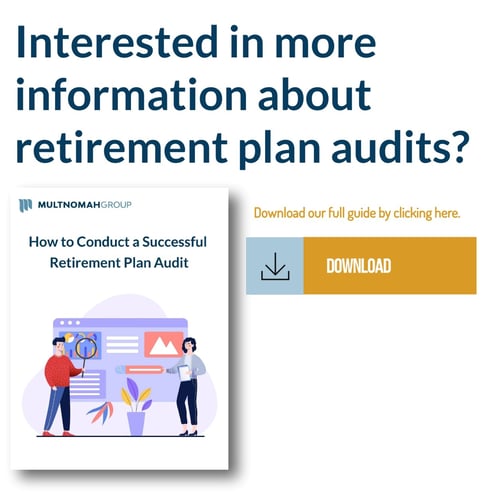 You work with your retirement plan administration vendor every year to complete your annual compliance requirements. It’s relatively easy, your process is smooth, and by now, it is an annual routine. But then, one year, you get an email from your plan administrator letting you know that you are now a “large plan.” And guess what? That requires an audit! What happened? What does that mean? What do you do?
You work with your retirement plan administration vendor every year to complete your annual compliance requirements. It’s relatively easy, your process is smooth, and by now, it is an annual routine. But then, one year, you get an email from your plan administrator letting you know that you are now a “large plan.” And guess what? That requires an audit! What happened? What does that mean? What do you do?
The reality is your organization has grown, and the retirement plan now has enough participants to require a yearly audit. The Employment Retirement Income Security Act of 1974 (ERISA) requires that plan financial statements be audited annually by an independent qualified public accounting firm. The requirement generally applies to plans with 100 or more participants.
First, make sure you do in fact qualify as a “large plan.” If you’ve simply breached 100 eligible participants, you may not need an audit yet. You might be able to utilize the 80-120 rule (see Section 4 of the Instructions for Form 5500). If you filed as a "small plan" last year and the number of plan participants is fewer than 121 at the beginning of this plan year, you may continue to file Schedule I as a "small plan" under the "80-120 Participant Rule." This rule allows plans with between 80 and 120 participants at the beginning of the plan year to file the Form 5500 in the same category ("large plan" or "small plan") as the prior year’s filing. However, once you make it to 121, you are forever an audited plan unless your count in the future falls below 100.
Once you are sure you are an audited plan, follow these guidelines to ensure a successful and smooth audit.
- First, find an auditor. Contact your accounting firm as they may provide this service. Or contact your retirement advisor for a referral.
- Next, contact your retirement plan vendor as many vendors offer audit support. Some vendors have significant support available to help decrease your burden.
- Prepare to work with your new auditor to assist them in gathering data and information (i.e., draft Form 5500, sampling of data, meeting minutes, etc.).
- Don’t wait! Begin work with your auditor on a timeline to complete all tasks so that the 5500 and the auditor’s opinion is filed on time.
After the audit is complete, use the audit as a tool to improve your plan operations and procedures.
- Review the auditor’s opinion and any qualitative and quantitative information to help strengthen your internal controls.
- Assess any risks regarding any auditor’s areas of concern.
- Discuss with your plan advisor and committee.
It’s important not to delay, to get a timeline in place, and work with your administrator, vendor, and advisor to complete your first audit. Once the foundation of success and a timeline are put in place, it should be sufficient to create a new process and annual routine going forward.
Multnomah Group is a registered investment adviser, registered with the Securities and Exchange Commission. Any information contained herein or on Multnomah Group’s website is provided for educational purposes only and does not intend to make an offer or solicitation for the sale or purchase of any specific securities, investments, or investment strategies. Investments involve risk and, unless otherwise stated, are not guaranteed. Multnomah Group does not provide legal or tax advice. Any views expressed herein are those of the author(s) and not necessarily those of Multnomah Group or Multnomah Group’s clients.

